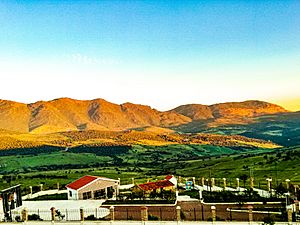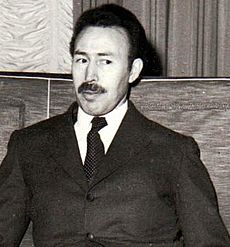Houari Boumédiène facts for kids
Quick facts for kids
Houari Boumédiène
هواري بومدين |
|
|---|---|
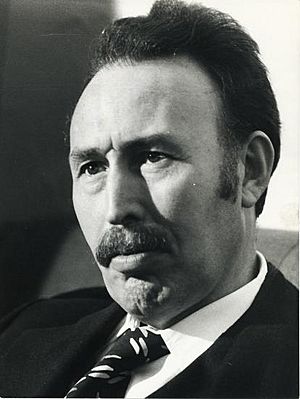 |
|
| 2nd President of Algeria | |
| In office 10 December 1976 – 27 December 1978 |
|
| Preceded by | Himself (as Chairman of the Revolutionary Council) |
| Succeeded by | Rabah Bitat (Interim) |
| Chairman of the Revolutionary Council | |
| In office 19 June 1965 – 10 December 1976 |
|
| Preceded by | Ahmed Ben Bella (as President) |
| Succeeded by | Himself (as President) |
| 4th Secretary General of Non-Aligned Movement | |
| In office 5 September 1973 – 16 August 1976 |
|
| Preceded by | Kenneth Kaunda |
| Succeeded by | William Gopallawa |
| 6th Chairperson of the Organisation of African Unity | |
| In office 13 September 1968 – 6 September 1969 |
|
| Preceded by | Mobutu Sese Seko |
| Succeeded by | Ahmadou Ahidjo |
| Personal details | |
| Born |
Mohamed Boukherouba
23 August 1932 Héliopolis, Guelma Province, Algeria |
| Died | 27 December 1978 (aged 46) Algiers, Algeria |
| Spouse | Anissa Boumédiène |
| Nickname | Houari Boumédiène |
| Military service | |
| Allegiance | Algeria |
| Branch/service |
|
| Years of service |
|
| Rank | Colonel |
| Battles/wars | Algerian War Sand War |
Houari Boumédiène (Arabic: هواري بومدين; 23 August 1932 – 27 December 1978) was an important leader in Algeria. He served as the head of the Revolutionary Council from 1965 to 1976. After that, he became the second President of Algeria until he passed away in 1978.
Contents
Early Life & Fight for Independence
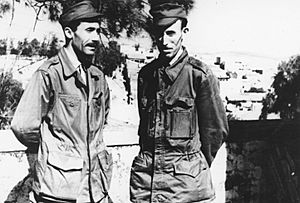
Houari Boumédiène was born Mohamed Boukherouba on August 23, 1932, near Guelma, Algeria. His family were farmers and strict Muslims. He was educated at an Islamic school in Constantine.
In 1955, he joined the National Liberation Front (FLN). This group was fighting for Algeria's independence from France. He chose the name Houari Boumédiène as his secret war name. He became a colonel, which was a very high rank in the FLN's army, called the ALN. From 1960, he was the chief of staff for the ALN.
Leading Algeria After Independence
After Algeria became independent in 1962, Boumédiène became the Minister of Defence. He helped Ahmed Ben Bella become the first leader of Algeria. However, Boumédiène disagreed with Ben Bella's way of governing.
In June 1965, Boumédiène took control of the country in a peaceful takeover. He then led Algeria through a group called the Revolutionary Council. Many of his supporters were military friends from the war. One of them was Abdelaziz Bouteflika, who later became president of Algeria. Boumédiène remained Algeria's strong leader until his death in 1978.
Building Algeria's Economy
Boumédiène focused on making Algeria's economy stronger. In 1971, he took control of the oil industry for the government. This greatly increased Algeria's money. He used this money to build many factories and industries. He wanted Algeria to become a major industrial country in North Africa.
Under his leadership, Algeria's economy grew steadily. After he died, oil prices dropped, and the state-run industries faced challenges. This led to changes in Algeria's economic policies later on.
Restoring Government & Stability
During the 1970s, Boumédiène slowly brought back political rules and government groups. He worked to restart activities within the FLN party. New local and regional groups were set up, leading to the election of a national parliament.
In 1976, a new constitution was approved. This constitution set up Algeria's political system. It also brought back the role of president, which Boumédiène took on in 1978. Even with these changes, the military remained very powerful in Algerian politics.
Under Boumédiène, Algeria saw big improvements. The population grew, and more people moved to cities. Income per person increased, and many more children went to school.
Algeria's Role in the World
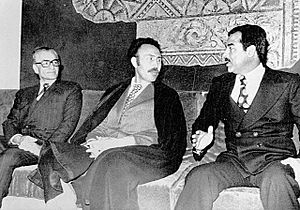
Boumédiène wanted Algeria to be friends with many countries, not just one side. This was called a policy of "non-alignment." He kept good relations with both communist and capitalist nations. He also worked to bring together countries that were not aligned with either side. He became a key figure in the Non-Aligned Movement.
He strongly supported groups fighting for freedom and justice in Africa and the Arab world. This included the PLO, the ANC, and SWAPO. Algeria also bought most of its weapons from the Soviet Union.
Western Sahara Conflict
A big issue for Algeria was the Western Sahara. In 1975, Boumédiène supported the people of Western Sahara to decide their own future. He allowed refugees and the Polisario Front (a liberation movement) into Algerian territory. This caused problems with Morocco, which also claimed the land. This disagreement between Algeria and Morocco continues to this day.
His Final Years
In 1978, Boumédiène became very ill. He died in Algiers on December 27, 1978, from a rare blood disease. His death left a big gap in Algerian leadership. After his passing, military leaders chose Colonel Chadli Bendjedid to become the new president.
Images for kids
-
Libyan Leader Muammar Gaddafi, Boumediene and Syrian President Hafez al-Assad in Tripoli, 1977.
See also
 In Spanish: Houari Boumédiène para niños
In Spanish: Houari Boumédiène para niños


